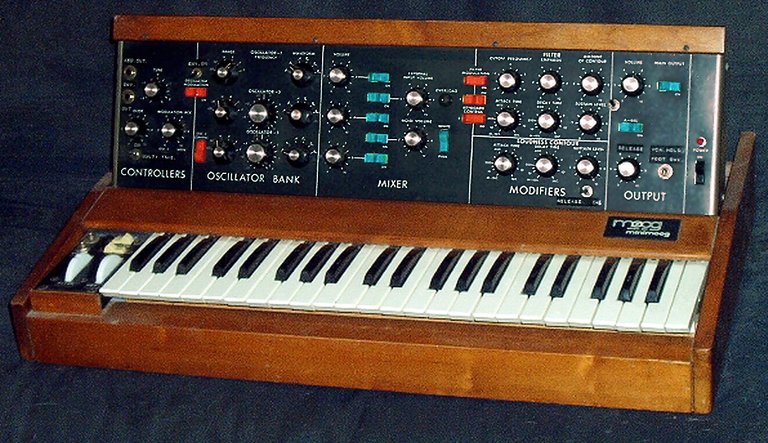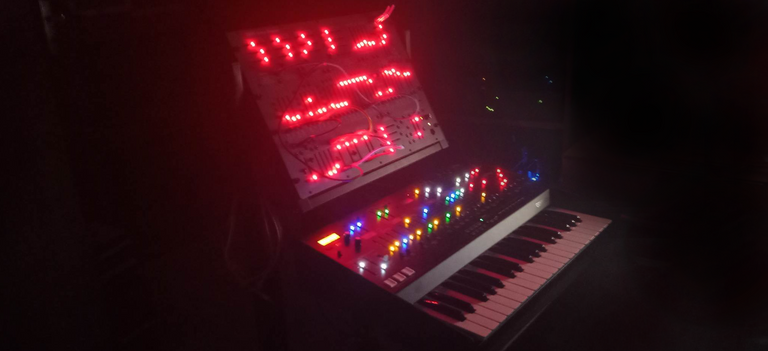
(Photo by me)
Behringer Odyssey: I love this synthesizer very much
Important note - before creating this post, I published it in my native language here: [ Link to polish version ] However I obviously put a lot of heart into it, so I would appreciate your help in promoting it. |
|---|
1. Introduction - What the heck are synthesizers? What odyssey are you talking about?
My dear readers, this post was written for two purposes - I wanted to show off my totally brilliant formatting skills and share my fixation on retro-synthesizers. The device I'm going to talk about today has its origins in 1972 when the legendary company ARP Instruments released a product called ARP Odyssey. According to the company's plans, it was intended to compete with the Minimoog (1970), a compact and easy-to-use synthesizer that was very popular at the time.
First incarnation of the Minimoog Model D (Source: https://en.wikipedia.org/wiki/Minimoog).
Fans of analog synthesizers Minimoog doesn't need to be introduced - to this day Minimoog Model D is still produced and highly regarded among music producers in particular, for its characteristic "fat" and "warm" sound, as well as its ease of use. However, it is not a product for every pocket - the price of an original Minimoog today is an expense of about 4500 USD (disgusting). The equipment I'm writing about today can be bought for as little as 450 USD (much cooler).
The creation of Minimoog marked an important step in the evolution of sound synthesis - Moog Music had in 1970 a strong track record in the production of so-called modular systems, i.e. a series of multiple electronic devices for generating and transforming sound, which, connected by audio cables, allowed the generation of sounds with different dynamics, timbre, sound.
The Minimoog, on the other hand, was a compact device, built from thoughtfully selected, most useful modules consisting of three tone-generating oscillators, a volume mixer, a low-pass filter and an ADSR envelope generator.
This device had no competition until 1972, when Arp and its Odyssey came out on stage (literally - on stage, because devices of this class, were primarily used as instruments for live performance) and proved to be a really big success for the company.
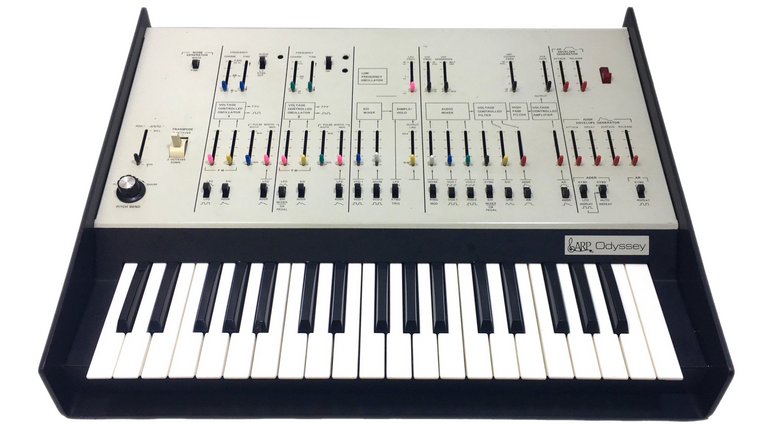
The original first ARP Odyssey model from 1972 (source: https://en.wikipedia.org/wiki/ARP_Odyssey)
Odyssey's advantages were primarily the high availability of features, with an equally small size as Minimoog. Odyssey's features include:
- Two keyboard-controlled oscillators (with extensive modulation possibilities using other modules like AR, ADSR, LFO or S/H)
- Low frequency oscillator (LFO)
- Filters - low-pass and high-pass
- Two envelopes generators - AR and ADSR
- Sample/Hold module (for generating random/pseudo-random pulses)
- Mixer with noise generator (white and pink) nad ring modulation [ definitely cool stuff ]
- Filter control module (which can also be controlled by any other module)
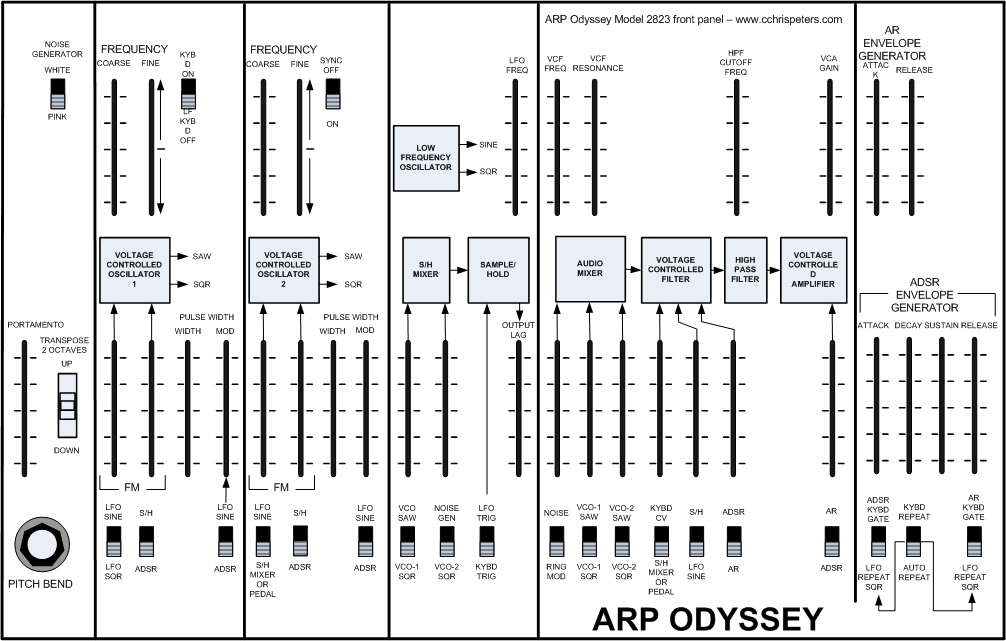
This is how the ARP Odyssey panel looks like (it has remained almost unchanged to this day). The schematic of how the device works is printed on it, which makes it very easy to learn (source: http://www.cchrispeters.com/SynthesizerGallery/ARPOdyssey.htm)
A clever concussion of the Odyssey, was to allow the user, to connect modules to each other, using switches - so it resembled modular synthesizers to a large extent, but did not require the use of external cables for operation - all connections could be switched with predefined switches and controlled with sliders (ARP did not like knobs...).
And the Odyssey's flaws?
Well, ymmm... Why is the damn thing so hard to tune! Really - the sliders for tuning the oscillators range from 20 to 20,000 HZ - to find and set with them the frequency corresponding to the sound A = 440HZ requires really surgical precision. Not only that - both oscillators get slightly out of tune when playing, and when they play simultaneously, they will practically never be in synchronization - instead, they will murmur, rasp, rumble, ripple - irritate and annoy... And now imagine tuning it during a concert, on stage xD My god...
But well - apparently it was meant to be like this - in this specificity, lies the character of Odyssey's sound, a certain metallicity, jitteriness, predation. Which doesn't mean that it can't also sound sprightly, soft and warm - of course it can (especially when the oscillators work in SYNC mode....
2. SYNC what?
So - oscillators can be synchronized and it is turbo-cool. I'm already explaining what's going on. So, as I mentioned earlier, we have two oscillators - both can generate the waveform of your choice: sawtooth or squere. When the two oscillators play together, through misalignment, we will usually hear a rippling sound resulting from the alternate amplification and weakening of the two waves.
Below are visualizations of waves made with the Wave Candy plugin from FL Studio. Sequentially sawtooth shaped, squere and and their sum. I generated the sound on a physical analog clone of ARP Odyssey from Behringer.
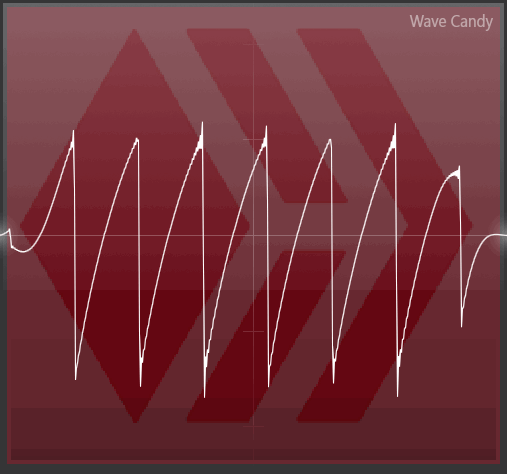 |  | |
|---|---|---|
 |
|---|
At the end of this post I've included a recording in which you can hear how the individual waves sound. Importantly, however, in the case of the sum of the signals, even looking at the animation, the dissonance I wrote about is noticeable - the summation and drift of the waves, making the signal consistently once quieter and once louder. To offset this effect, the second oscillator has a SYNC switch - it makes the second oscillator (the so-called "slave") reset its cycle after each cycle of the first oscillator and start again. The sound generated in this way, will sound like it is playing at the frequency of the first oscillator, when the second one modifies the timbre of the sound by adding aliquots (additional harmonic frequencies) to it. In this situation, no matter how tuned the second oscillator is, the sound will always remain harmonic - it is even popular in Odyssey to variously modify the frequency of the slave oscillator, so that every key press on the keyboard, results in a distinctive, warm and springy shot.
Below is an animation, showing the synchronization of a standard squere wave, with a second squere wave, but with increasing frequency.
 | + | 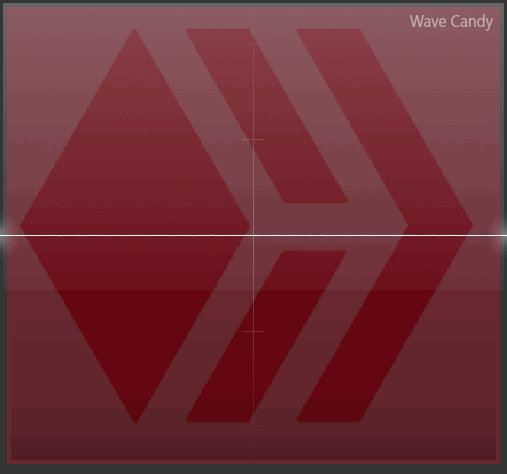 |
|---|
SYNCHRONIZATION SIGNALS


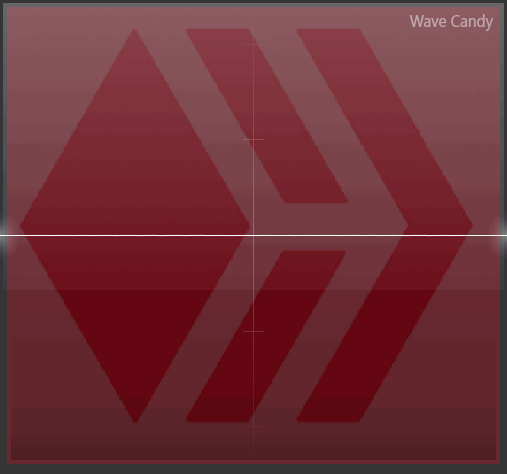
Pretty cool, isn't it? Naturally, you can hear what it sounds like in the video at the end of the post.
It's worth for me to mention at least a little bit more about the Sample/Hold module - because it is one of the non-obvious, but mega-fun Odyssey modules - pure fun. Sample/Hold (abbreviated to S/H and that's the name I'll continue to use) activates with each cycle of the LFO module, so from 0.2 to 20 times per second (depending on the setting). It analyzes the incoming waveform and generates a corresponding pulse with the appropriate frequency. For example, when detecting a peak in the waveform, it emits a high-frequency pulse, while identifying a trough results in a low-frequency pulse. When a signal from the oscillator is supplied to the S/H module, as the oscillator is constantly repeating cycles (at its own frequency), the S/H module will also read values in cycles - although the values it reads will be random, they will cycle).
When we supply a squere wave to the S/H, the pulses will get the highest or lowest value, and when a sawtooth wave, the sounds may be random, but in repeated cycles. We can also supply noise to the S/H, so that it will generate random signals (by reading random noise values).
Sometimes heard especially in funk music is a procedure involving rhythmic changes in the frequency of slave oscillator (using SYNC).
 | + |  | = | 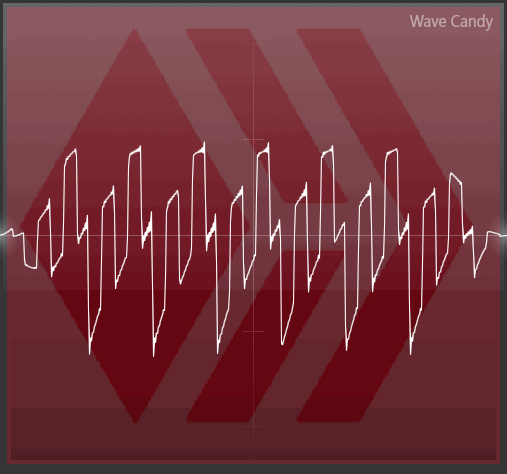 |
|---|---|---|---|---|
squere signal (mod. by S/H) | combined signal (SYNC) |
An example of how the Behringer Odyssey sounds in such a configuration, you can hear in the video below - the quality of the sound I recorded is unfortunately poor, as I deemed my nasty improvisation unworthy of being listened to by anyone and anytime, and thus deleted the original recording (the final recorded sound comes from the microphone on the phone). Nevertheless, for teaching purposes.... Here you go:
3: And what?
And that's it. That is, as far as the technicalities are concerned - after all, I won't describe all the possible configurations of this equipment, as it is used for experimentation, and the selection of modules included in it allows you to create a great many sounds (more about that, perhaps, when I create a post on the sister synth to Odyssey - the semi-modular ARP 2600 (that's the one above Odyssey in the first photo).
And how did I get interested in ARP Odyssey? Well - it started with George Duke. He is by far my favorite musician using this instrument. Duke mostly kept his Odyssey next to the Minimoog, claiming that the two synthesizers complement each other very well in their capabilities. In his music, he used the Odyssey in particular to add a bit of chaos to his performances.

(source: Youtube - Billy Cobham & George Duke Band - Live At Montreux Jazz Festival (1976) - recommended, nice live. ARP Odyssey, that's the gray dude in the lower right corner of the image).
Other popular artists using ARP Odyssey in their music are, of course, Herbie Hancock (his Chameleon is insane funky shit to this day - I recommend it warmly), Kraftwerk, Joy Division, Gary Numan, Brian Eno or Jean-Michel Jarre (somehow I'm not a fan of the latter, but my mother says he was a great musician, so out of respect I believe her (only because of respect)).
There is also this guy on YouTube. Well I have to admit that this guy is brilliant. On the channel he has several tracks recorded with Arp Odyssey (in a miniature version of Korg).
And finally, the promised two of my videos:
The first one with a presentation of how the waveforms I put in the animations sound:
And the second one, just for fun and made on short notice, where I recreate with Odyssey the main theme from the game Puzzle Bobble (Bust-a-Move). Watch to the end please, because at the end of the footage I put a board especially for you with a VERY IMPORTANT request.
Warm regards ;)
Do you want more? Write comments and I am also on https://openhive.chat/ - come, you are invited, let's write about anything.
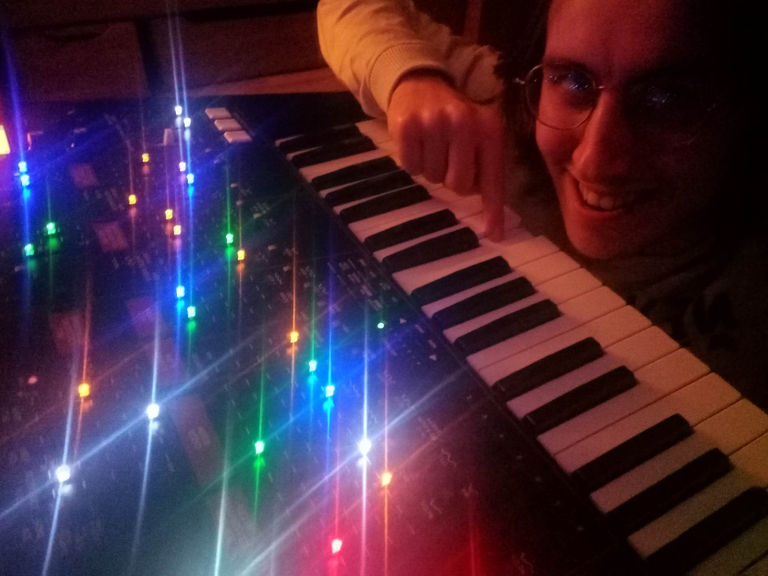
(Photo by nerd gremlin me also.... With my Behringer Odyssey - I love it very much)
